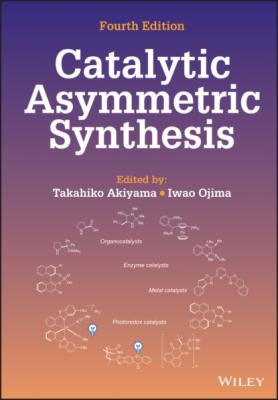Catalytic Asymmetric Synthesis. Группа авторов
Чтение книги онлайн.
Читать онлайн книгу Catalytic Asymmetric Synthesis - Группа авторов страница 65
 chiral tertiary amine catalysis still possesses inherent critical limitations; high catalyst loadings and long reaction times are often required, and arguably the range of pronucleophiles and electrophiles that are applicable to the reactions is rather narrow, which stem from the low basicity of tertiary amines. Only highly acidic compounds are applicable as pronucleophiles, and thus the resulting anionic nucleophiles only possess moderate nucleophilicity to react with highly electrophilic compounds. In this context, chiral uncharged organobases having higher basicity than chiral tertiary amines have attracted increased attention. This class of chiral organobases, including conventional chiral guanidines, is often called “chiral organosuperbase” although the definition of the term “organosuperbase” is rather ambiguous [1b]. The application of chiral organosuperbases has significant advantages. Most importantly, the chiral organosuperbases potentially broaden the scope of pronucleophiles to compounds having higher pK a values. In addition, the chiral organosuperbases increase the concentration of anionic nucleophiles. Consequently, they can dramatically accelerate the bimolecular reactions and decrease the catalyst loading and reaction time. Over the last decade, some new types of chiral organosuperbase catalysts have been developed, which is overviewed in this section.
chiral tertiary amine catalysis still possesses inherent critical limitations; high catalyst loadings and long reaction times are often required, and arguably the range of pronucleophiles and electrophiles that are applicable to the reactions is rather narrow, which stem from the low basicity of tertiary amines. Only highly acidic compounds are applicable as pronucleophiles, and thus the resulting anionic nucleophiles only possess moderate nucleophilicity to react with highly electrophilic compounds. In this context, chiral uncharged organobases having higher basicity than chiral tertiary amines have attracted increased attention. This class of chiral organobases, including conventional chiral guanidines, is often called “chiral organosuperbase” although the definition of the term “organosuperbase” is rather ambiguous [1b]. The application of chiral organosuperbases has significant advantages. Most importantly, the chiral organosuperbases potentially broaden the scope of pronucleophiles to compounds having higher pK a values. In addition, the chiral organosuperbases increase the concentration of anionic nucleophiles. Consequently, they can dramatically accelerate the bimolecular reactions and decrease the catalyst loading and reaction time. Over the last decade, some new types of chiral organosuperbase catalysts have been developed, which is overviewed in this section.
3.4.1. Chiral Cyclopropenimine Catalysts
In 2012, Lambert and Bandar introduced chiral cyclopropenimines as a powerful class of chiral organobase catalysts for the first time (Figure 3.10) [81].
The basicity of 31 was measured and found to be higher than that of guanidines and comparable to that of P1‐phosphazenes. Their high basicity is attributed to the stabilization of the conjugate acid by three nitrogen lone pairs and an aromatic cyclopropenium ion. The superior catalytic activity of 31 was demonstrated in the enantioselective additions of glycine imines to various kinds of Michael acceptors and imines (Scheme 3.45) [82].
The mechanistic rationale was provided based on the experimental results along with computational study (Figure 3.11) [83]. The lowest‐energy enantiodetermining transition state involves the (E)‐enolate hydrogen‐bonded to the N‐H function of the protonated catalyst, with the acrylate hydrogen‐bonded to the catalyst hydroxy group. Interestingly, an unusual intramolecular C‐H… O interaction between a hydroxy group and a cyclohexane ring was identified as a key element in transition‐state organization.
Figure 3.10. Chiral cyclopropenimine catalyst.
Scheme 3.45. Enantioselective additions of glycine imines catalyzed by 31.
Source: Based on [82]. Source: Based on [81] and [82].
Figure 3.11. Mechanistic rationale.
Source: [83].
Jørgensen and co‐workers developed the enantioselective [3+2] cycloaddition of glycine imines with 2‐acyl cycloheptatrienes by using 31 (Scheme 3.46) [84]. 31 was also utilized in the catalytic enantioselective [2,3]‐Wittig rearrangement [85].
Scheme 3.46. Enantioselective [3+2] cycloaddition of glycine imines with 2‐acyl cycloheptatrienes catalyzed by 31.
Source: Based on [84].
3.4.2. Chiral Triaryliminophosphorane Catalysts
Dixon and co‐workers designed and developed a series of chiral bifunctional iminophosphorane (BIMP) catalysts 32 based on their idea of the introduction of an enhanced organobase functionality relative to tertiary amines into chiral acid–base bifunctional catalysts (Figure 3.12) [86].
Figure 3.12. Chiral bifunctional iminophosphorane (BIMP) catalysts.
The basicity of N‐alkyl triaryliminophosphorane was determined to be comparable to that of guanidines. The attractive feature of the catalyst design is high modularity. The catalysts incorporating a variable hydrogen bond donor, chiral amino acid‐derived scaffold, and triaryliminophosphorane are readily synthesized via a last step Staudinger reaction of a chiral organoazide and a triarylphosphine. The synthetic potential of this class of catalysts was first demonstrated in the enantioselective addition of nitromethane to ketimines catalyzed by 32a in 2013 (Scheme 3.47) [87].
Scheme 3.47. Enantioselective addition of nitromethane to ketimines catalyzed by 32a.
Source: Based on [87].
After that, the BIMP catalysts 32 were successfully utilized in several enantioselective reactions (Scheme 3.48). For instance, a series of enantioselective sulfa‐Michael additions including that with α‐substituted acrylates was developed (Scheme 3.48a) [88]. On the other hand, the enantioselective synthesis of conjugated cyclohexanones through a facial selective 1,3‐proton shift was achieved by using 32c (Scheme 3.48b) [89]. The related enantioselective 1,3‐proton shift was also utilized in the total synthesis of a natural product, (‐)‐himalensine A [91]. Furthermore, 32d having a sterically demanding amide moiety efficiently promoted the direct aldol addition of less acidic acetophenone derivatives to α‐fluorinated ketones to provide the corresponding adducts in high yields with high enantioselectivities (Scheme 3.48c) [90]. Johnson and co‐workers utilized the BIMP catalysts in their development of enantioselective reactions, such as the enantioselective additions of nitroalkanes and alkyl thiols to enone diesters, and the enantioselective three‐component